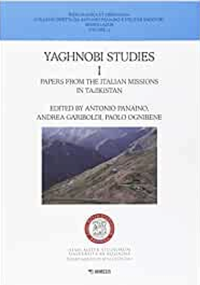
Antonio Panaino, Andrea Gariboldi, Paolo Ognibene, Preface; Part I: The History of the Yaghnobis in the Framework of the upper Zarafšan Region; Antonio Panaino, The Yaghnobis and Their Valley: towards a New Historical Perspective; Antonio Panaino, The Yaγnob Valley in the Framework of the History of the Sogdian Upper Zarafšan: a Political and Economical Point of View; Andrea Gariboldi, Materials for the Sylloge Nummorum Sasanidarum Tajikistan; Gian Pietro Basello, Paolo Ognibene, A Black Dog from Marzič: Legends and Facts about Anzob Plague; Part II: Ethno-Linguistics of the Yaghnobis and Related Problems; Paolo Delaini, Traditional Medicine in the Yaghnob Valley. Notes on Body Therapy, Pregnancy and Birth Care; Elisabetta Cilli, Sara De Fanti, Paolo Delaini, Antonio Panaino, Giorgio Gruppioni, A Contribution to Genetic History of the Yaghnobis of Tajikistan through Mitochondrial DNA Analysis; Daniele Guizzo, Who are the Yaghnobis? Past, Present and Future of a Minority; Paolo Ognibene, Political Use of History. The Case of the Sogdian Legacy in post-Soviet Tajikistan; Antonio Panaino, The Position of the Yaghnobi Language According to the New Legislation of the Republic of Tajikistan; Stella Beghini, Narratives fro Tajik Mountainous Villages: the Contemporary Intersection of Environmental Degradation Problems and Development Issues; Appendix. Nunziatina Fragale, Per una carta archeologica dell’alta valle dello Zarafšan (Matča) e dello Yaghnob.
The present volume collects some contributions about the Yaghnob Valley inspired by or directly developed in the framework of the various scientific missions of the University of Bologna in Tajikistan (2007-2012). The articles here collected follow, as far as it is possible, a chronological order, strating with the studies concerning the history of the Yaghnobis considered in the framework of the Upper Zarafšan region, beginning from the Sogdian period to the early Islamic age, up to those essays focusing on ethno-linguistics and related political aspects. Thus, old questions have to face new problems and social needs, in a very delicate and politically complex area, which now is experiencing a deep economic crisis, but that holds important energetic and mining resources. Both the researchers aiming to clarify which were the political and economic role of the Yaghnob Valley during the Sogdian period, and the studies that try to explain the peculiar use and development of the Yaghnobi language, in the light of the socio-cultural politics of the Republic of Tajikistan, deserve great attention. From different point of view it has been deeply discussed the problem of the Yaghnobis’ isolation and uniqueness: the results seem to be very innovative. Also particular historical cases, such as the terrible Anzob plague (1898) have been analysed as a case-study in order to better understand the Czarist policy towards minorities in Central Asia, a relevant theme in Soviet and post-Soviet time, too. The strong humanitarian profile of these missions is well represented by some pharmacological and medical contributions. Finally, useful and detailed maps of the Yaghnob Valley, created with GIS technology, were included at the end of the volume.
